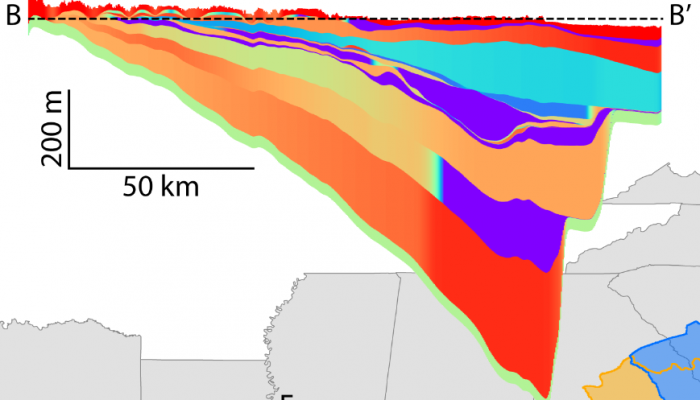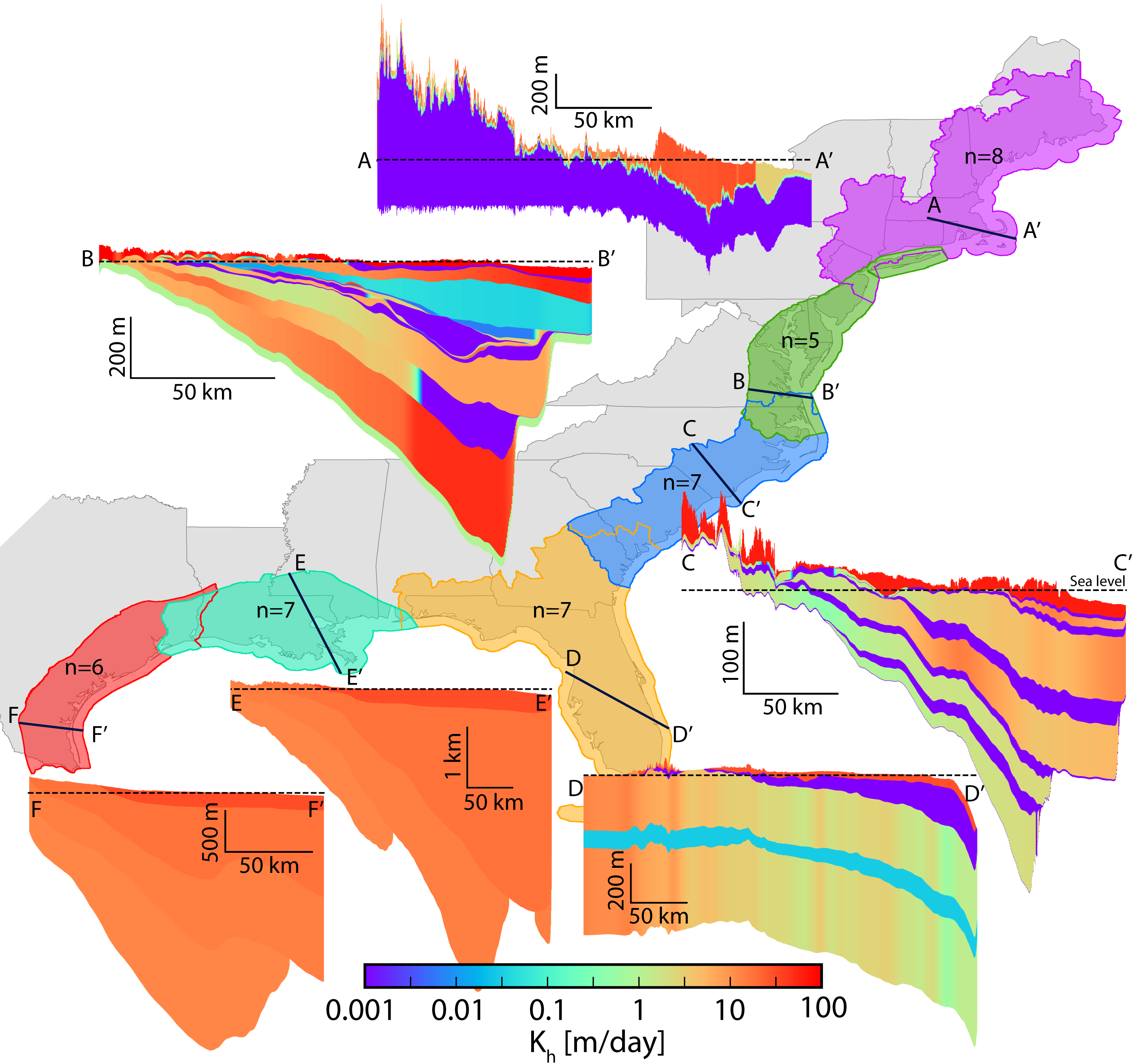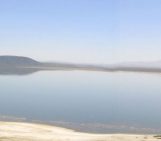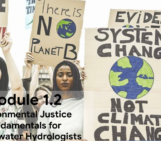
Post by Kevin Befus, Assistant Professor at the College of Engineering and Applied Science at the University of Wyoming, in the United States.
__________________________________________________

3D geologic data can be hard to come by, and can be even more difficult to combine into a continuous dataset. The cross-sections shown here are directly from 3D groundwater models that I compiled [Befus et al., 2017], primarily from USGS groundwater models, for the U.S. East Coast. I kept each of the regional domains (different color swaths on the map) separate, since I ran into the issue of “border discontinuities” between different models where naming conventions and hydrostratigraphic structure didn’t match up. Kh is the horizontal hydraulic conductivity.
We’ve all been asked (or do the asking), “where does your water come from?” This is a fundamental question for establishing a series of additional questions that can ultimately help define strategies for valuing and protecting a particular water resource.
For groundwater, we could phrase this question differently, and I often do when talking to well owners: How deep is your well? If I get an answer to this, then I can dive into additional questions that can help define more about the local groundwater resource: How deep is the well screen? How long is the screen? Do you know what the water level in the well is? Has it changed over some given time? Seasonally?
These are all useful questions, and they serve to begin establishing the hydraulic conditions of a particular aquifer. I ask these whenever I can.
To do this at a larger scale, we can turn to various governmental agencies that regulate groundwater resources and/or water well drilling and often collect and store groundwater data (e.g., www.waterqualitydata.us/, http://nlog.nl/en/data, http://gin.gw-info.net/service/api_ngwds:gin2/en/gin.html, or http://www.bgs.ac.uk/research/groundwater/datainfo/NWRA.html). There is a wealth of information out there internationally on wells when they were drilled and where the driller first hit water. These driller logs can provide a snapshot in time of the water table elevation and can be extremely useful for tracking hydrologic variability [Perrone and Jasechko, 2017], extracting hydraulic parameters [Bayless et al., 2017], and for testing model results [Fan et al., 2013]. Unfortunately for us earthy nerds, some governments have restricted access to well installation data for either certain types of wells (i.e., municipal) or for all wells, usually for privacy or safety concerns.
Back to the original question. How deep is groundwater? I keep this question broad. We can usually answer this question for particular areas where we have access to the right data, but for large parts of the globe, and potentially underneath you right now, we cannot answer this question. The “right data” for a hydrogeologist is some form of information on geologic/stratigraphic layer (or lack of layering) that can be tied to the rock properties. For a surficial, unconfined aquifer, this can be relatively easy, but when we start stacking several geologic units on top of each other or start actually using the groundwater, this question of how deep groundwater is becomes tricky. We could qualify this question by asking how deep “usable” groundwater is, which, of course, depends on our definition of usable water for a specific purpose. Or, we can point (or integrate) through the Earth’s crust, core, and right back to its crust and calculate the huge value of how much water is “in the ground” (and minerals)[Bodnar et al., 2013]. And I haven’t even brought up porosity yet! Or specific storage!
A example of a great public 3D interactive web viewer (https://wateratlas.net/) that integrates groundwater data, geological information, and well construction details produced by the Centre for Coal Seam Gas at the University of Queensland (https://ccsg.centre.uq.edu.au/), which is supported by the University of Queensland and industry partners. For more information on this water atlas, please contact Dr. Sue Vink (s.vink@smi.uq.edu.au) or Alexandra Wolhuter (a.wolhuter@uq.edu.au).
Don’t worry. I won’t go there. I want to harass/encourage the hydro[geo]logic community to get serious about sharing their hydrogeologic data. This does mean metadata (do I hear a collective groan?), but metadata and data management plans are increasingly required to secure funding. CUAHSI’s Hydroshare site (www.hydroshare.org) provides a platform uploading hydro models, and the U.S. Geological Survey has developed a slick web system for exploring hydrogeologic models. But, I’d like to take this further, or at least get a service like that going for anyone who wants to share their models. There is a wealth of crustal structure data out there, and groundwater models are unique in often containing some representation of three-dimensional geology/hydrostratigraphy along with Earth properties. There are some great deterministic, published datasets and models of global hydrogeology [De Graaf et al., 2015; Huscroft et al., 2018], but we can do better. Wouldn’t it be great to have a centralized database to extract an ensemble of hydrogeologic structure used in previous regional or local studies? How about be able to draw a model boundary on a web interface and extract 3D structure for your next model? And compare cross-sections between models in the same area? Want to start fitting your puzzle pieces into the international hydrogeologic puzzle? The question now becomes, how do we do it? A “DigitalCrust” has been proposed [Fan et al., 2015], but is not yet in reach.
Join the movement of a “Digital Earth” [Gore, 1998]!
Here are some examples, initiatives, and free 3D [hydro]geology resources to get you started:
- 3D geology of Great Britain: http://mapapps.bgs.ac.uk/geologyofbritain3d/index.html
- Macrostrat: interactive geologic map with regional rock columns (https://macrostrat.org)
- Visible Geology: interactive exploration of 3D structure (https://app.visiblegeology.com/)
- Geomodelr: Create your own 3D models online (https://geomodelr.com/)
- Queensland Water Atlas: Incredible 3D web interface, combining 3D model strucuture with well logs and more (https://wateratlas.net/)
- Visual3D: European initiative to develop and visualize 3D/4D geomodels (http://www.visual3d.info/)
- Previous Water Underground posts on crustal permeability:
- https://blogs.agu.org/waterunderground/2015/09/03/how-easily-does-our-understanding-of-crustal-permeability-flow-a-new-geofluids-special-edition/
- https://blogs.agu.org/waterunderground/2015/08/05/a-new-data-portal-for-permeability/
- https://blogs.agu.org/waterunderground/2014/09/29/communicating-research-results-through-comics-is-the-permeability-of-crystalline-rock-in-the-shallow-crust-related-to-depth-lithology-or-tectonic-setting/
__________________________________________________

.
Kevin Befus leads the groundwater hydrology group in the Civil and Architectural Engineering Department at the University of Wyoming. With his research group, he studies how groundwater systems respond to hydrologic conditions over glacial timescales and in mountainous and coastal environments. You can follow along with Kevin’s research through any of the links below:
Personal Webpage | Twitter | Research Group Page | UW Faculty Page
.
.
References
Bayless, E. R., L. D. Arihood, H. W. Reeves, B. J. S. Sperl, S. L. Qi, V. E. Stipe, and A. R. Bunch (2017), Maps and Grids of Hydrogeologic Information Created from Standardized Water-Well Driller’s Records of the Glaciated United States, U.S. Geol. Surv. Sci. Investig. Report2, 2015–5105, 34, doi:10.3133/sir20155105.
Befus, K. M., K. D. Kroeger, C. G. Smith, and P. W. Swarzenski (2017), The Magnitude and Origin of Groundwater Discharge to Eastern U.S. and Gulf of Mexico Coastal Waters, Geophys. Res. Lett., 44(20), 10,396-10,406, doi:10.1002/2017GL075238.
Bodnar, R. J., T. Azbej, S. P. Becker, C. Cannatelli, A. Fall, and M. J. Severs (2013), Whole Earth geohydrologic cycle, from the clouds to the core: The distribution of water in the dynamic Earth system, Geol. Soc. Am. Spec. Pap., 500, 431–461, doi:10.1130/2013.2500(13).
Fan, Y., H. Li, and G. Miguez-Macho (2013), Global patterns of groundwater table depth, Science, 339(6122), 940–943, doi:10.1126/science.1229881.
Fan, Y. et al. (2015), DigitalCrust – a 4D data system of material properties for transforming research on crustal fluid flow, Geofluids, 15(1–2), 372–379, doi:10.1111/gfl.12114.
Gore, A. (1998), The Digital Earth: Understanding our planet in the 21st Century, Aust. Surv., 43(2), 89–91, doi:10.1080/00050326.1998.10441850.
De Graaf, I. E. M., E. H. Sutanudjaja, L. P. H. Van Beek, and M. F. P. Bierkens (2015), A high-resolution global-scale groundwater model, Hydrol. Earth Syst. Sci., 19(2), 823–837, doi:10.5194/hess-19-823-2015.
Huscroft, J., T. Gleeson, J. Hartmann, and J. Börker (2018), Compiling and Mapping Global Permeability of the Unconsolidated and Consolidated Earth: GLobal HYdrogeology MaPS 2.0 (GLHYMPS 2.0), Geophys. Res. Lett., 45(4), 1897–1904, doi:10.1002/2017GL075860.
Perrone, D., and S. Jasechko (2017), Dry groundwater wells in the western United States, Environ. Res. Lett., 12(10), 104002, doi:10.1088/1748-9326/aa8ac0.




